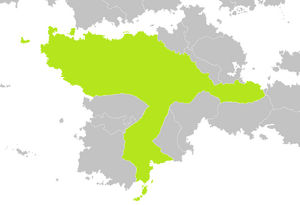Adamdar Empire
The Adamdar Empire, also known as the Adamdar State, the Adamdar Khaganate was a Nomadic empire that came to rule over much of Siduri from 1259 to 1754.
The Adamdar were originally a nomadic Turkic tribe that originated with the Liezue confederation, residing on the central Siduri steppe since antiquity. The Burning Plague paved the way for the assertion of the Adamdar as one of the major tribes of southern Naran Dahyu, supplementing the Shirvani and Erani peoples as the major powers in the region. In 1259 Temiarlan Khan united the Adamdar tribes and subjugated the other steppe peoples of central Siduri to form the Empire. Taking advantage of the aftermath of the War of the Marked, Temiarlan Khan proceeded to conquer the rest of Shirvaniya before forging an alliance with Kiều Thạc Nhu. While Nhu invaded the Rideva Empire Temiarlan Kha waged war against the Symmerian Empire, invading Ruvelka and Syara before decisively defeating the Symmerians at the Battle of Nemaro in 1305. The battle brought an end to 1,551 years of Symmerian rule over north-west Siduri and is today known as the Imperial Collapse. Temiarlan Khan then waged war against the Rawwadid Sultanate, expanding his empire into Mansuriyyah.
The Adamdar ruled their empire through subjugated client states known as Khanate, usually centered on pre-existing polities who were ruled over by an appointed Khan (typically a member of the Khaganate's family). The Khanate were required to supply annual tribute to the Adamdar as well as supply soldiers and resources for wars, as well as enforce decrees issued by the Khaganate. Deviation or refusal to obey Adamdar rule was met with collective punishment; the most significant was in the aftermath of the Symmerian Rebellion, that resulted in the destruction of the Symmerian capital of Parilla, and the reorganization of the Symmerian Khanate into the Rioni Union (although the Adamdar continued to identify it as the Symmerian Khanate). Like the Symmerians before them, the Adamdar made little effor to incorporate the vast array of ethnic groups, tribes, and nationalities under their banner into a single coherent identity, but nevertheless harshly punished any usurpation of their rule.
Beginning in the mid-15th Century previously peaceful relations with the Kiếm Hoà Dynasty began to deteriorate, leading to several armed conflicts that contributed to the dissolution of the Kiếm Hoà and the formation of the Northern and Southern Dynasties. Under Curzahn Khan the Adamdar invaded south-western Siduri and conquered large swathes of Nalaya, bringing the Empire into conflict with Tennai in what became known as the Nalayan Wars. The Empire later took part in the First Chryse War against the Shalumite Empire and Górska, temporarily expanding Adamdar influence into Eracura.
By the 17th Century Adamdar power was beginning to wane as internal conflicts and dynastic struggles ate away at the Empire's strength. Civil wars and foreign conflicts against increasingly numerous adversaries weakened the central power of the Khaganate, while many of the Empire's client Khanates began to rise in power relative to the central government. The Empire would go on to suffer a string of military defeats against Knichus and the Islamic Caliphates of Mansuriyyah, depleting the Empire's already exhausted treasury. Between 1670-1710 the Adamdar waged a series of unsuccessful campaigns against Kashmala I Mannadi, who later encourged and supported the Rioni Union during the Rioni War of Independence. The loss of the Rioni Union effectively marked the end of the Adamdar as a major power; the Empire receded back into Shirvaniya and dissolved in 1754 into various squabbling Khanates.
The Adamdar were the last of the "Steppe Empires" that had ruled over and influenced Siduri since the 3rd Millennia BCE. Although predominantly recalled for the brutality and violence exhibited by the Adamdar armies during their conquests, the Adamdar made significant contributions to the transfer of knowledge, science, mathematics, and trade, returning Siduri to a level of interconnectivity that had not been since since before the Crisis of the Ninth Century. The influence and rule of the Adamdar effectively set in motion of the creation of the modern-nation states of Siduri and thus their rule is often used by historians to mark the transition from the Medieval to the Modern Era, as well as mark the transition of Siduri away from continental empires and hegemonies and towards independent regional powers. The Adamdar people themselves would return to prominence during the years of the Cacertian Empire in the late 19th and early 20th Centuries.

